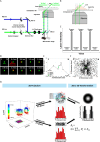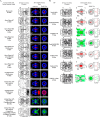Application of Super-resolution SPEED Microscopy in the Study of Cellular Dynamics
- PMID: 37501792
- PMCID: PMC10369678
- DOI: 10.1021/cbmi.3c00036
Application of Super-resolution SPEED Microscopy in the Study of Cellular Dynamics
Abstract
Super-resolution imaging techniques have broken the diffraction-limited resolution of light microscopy. However, acquiring three-dimensional (3D) super-resolution information about structures and dynamic processes in live cells at high speed remains challenging. Recently, the development of high-speed single-point edge-excitation subdiffraction (SPEED) microscopy, along with its 2D-to-3D transformation algorithm, provides a practical and effective approach to achieving 3D subdiffraction-limit information in subcellular structures and organelles with rotational symmetry. One of the major benefits of SPEED microscopy is that it does not rely on complex optical components and can be implemented on a standard, inverted epifluorescence microscope, simplifying the process of sample preparation and the expertise requirement. SPEED microscopy is specifically designed to obtain 2D spatial locations of individual immobile or moving fluorescent molecules inside submicrometer biological channels or cavities at high spatiotemporal resolution. The collected data are then subjected to postlocalization 2D-to-3D transformation to obtain 3D super-resolution structural and dynamic information. In recent years, SPEED microscopy has provided significant insights into nucleocytoplasmic transport across the nuclear pore complex (NPC) and cytoplasm-cilium trafficking through the ciliary transition zone. This Review focuses on the applications of SPEED microscopy in studying the structure and function of nuclear pores.
© 2023 The Authors. Co-published by Nanjing University and American Chemical Society.
Conflict of interest statement
The authors declare no competing financial interest.
Figures




References
-
- Shakouri A.; Ziabari A.; Kendig D.; Bahk J. H.; Xuan Y.; Ye P. D.; Yazawa K.; Shakouri A.. Stable thermoreflectance thermal imaging microscopy with piezoelectric position control. In 2016 32nd Thermal Measurement, Modeling & Management Symposium (SEMI-THERM), 14–17 March 2016, 2016; pp 128–132. DOI:10.1109/SEMI-THERM.2016.7458456 - DOI
-
- Gardill A.; Kemeny I.; Li Y.; Zahedian M.; Cambria M. C.; Xu X.; Lordi V.; Gali Á.; Maze J. R.; Choy J. T.; et al. Super-resolution airy disk microscopy of individual color centers in diamond. ACS Photonics 2022, 9 (12), 3848–3854. 10.1021/acsphotonics.2c00713. - DOI
Publication types
Grants and funding
LinkOut - more resources
Full Text Sources
